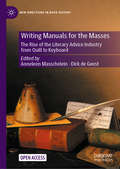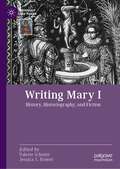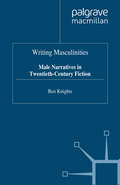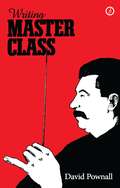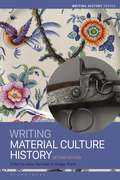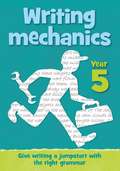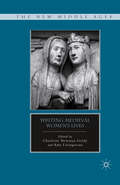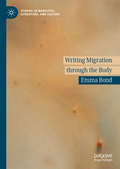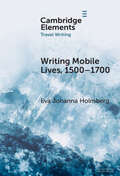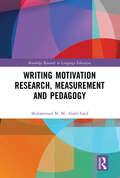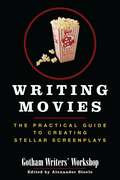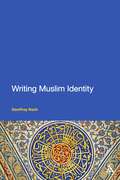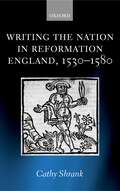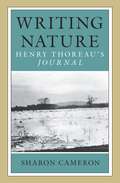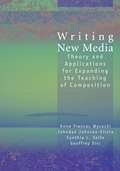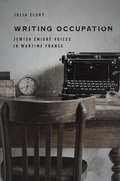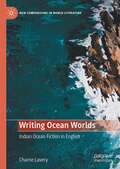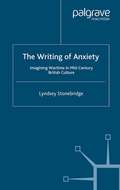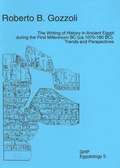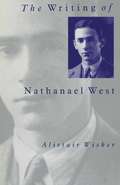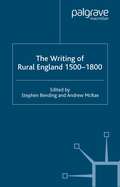- Table View
- List View
Writing Manuals for the Masses: The Rise of the Literary Advice Industry from Quill to Keyboard (New Directions in Book History)
by Anneleen Masschelein Dirk De GeestThis open access collection of essays examines the literary advice industry since its emergence in Anglo-American literary culture in the mid-nineteenth century within the context of the professionalization of the literary field and the continued debate on creative writing as art and craft. Often dismissed as commercial and stereotypical by authors and specialists alike, literary advice has nonetheless remained a flourishing business, embodying the unquestioned values of a literary system, but also functioning as a sign of a literary system in transition. Exploring the rise of new online amateur writing cultures in the twenty-first century, this collection of essays considers how literary advice proliferates globally, leading to new forms and genres.
Writing Mary I: History, Historiography, and Fiction (Queenship and Power)
by Valerie Schutte Jessica S. HowerThis book—along with its companion volume Mary I in Writing: Letters, Literature, and Representations—centers on representations of Queen Mary I in writing, broadly construed, and the process of writing that queen into literature and other textual sources. It spans an equally wide chronological and geographical scope, accounting for the years prior to her accession in July 1553 through the centuries that followed her death in November 1558 and for her reach across England, and into Ireland, Spain, Italy, Russia, and Africa. Its intent is to foreground words and language—written, spoken, and acted out—and, by extension, to draw out matters of and conversations about rhetoric, imagery, methodology, source base, genre, narrative, form, and more. Taken together, these volumes find in England’s first crowned queen regnant an incomparable opportunity to ask new questions and seek new answers that deepen our understanding of queenship, the early modern era, and modern popular culture.
Writing Masculinities: Male Narratives in Twentieth-Century Fiction
by Ben KnightsThe great bulk of work on gender in fiction and literature has reflected feminist concerns and focused on women authors. This book attempts to extend the contemporary preoccupation with representations of gender into the terrain of masculinity and male writing. Drawing on work in both the social sciences and humanities, it explores the narrative representation of masculinity in selected twentieth-century fictions ranging from classic texts by Lawrence and Conrad to novels by John Fowles, Graham Swift, David Leavitt and others.
Writing 'Master Class'
by David PownallWriting Master Class is the biography of David Pownall’s play, Master Class (1983), from conception to coming of age. Threaded through the account of the inception and development of the piece are twists of authorial life-story necessary for the telling. Whereas a novel or poem can be kept a secret until it is properly finished, a play has to go out to meet the people early. On the day the script is put into the hands of actors, the soul of the thing passes out of the author’s control. It can be bent, battered, warped – or improved within its being far beyond expectations. As a drama of dictatorship in art and the cleverness needed to evade its worst manifestations, Master Class has been at large for thirty years, produced in twenty countries, in some several times. What has been done to it, how it has fared, is touched upon but the main story in this book is the making of the piece. This is a fascinating insight into the playwright’s craft.
Writing Material Culture History (Writing History)
by Edited byAnne Gerritsen and Giorgio RielloWriting Material Culture History examines the methodologies currently used in the historical study of material culture. Touching on archaeology, anthropology, art history and literary studies, the book provides history students with a fundamental understanding of the relationship between artefacts and historical narratives. The role of museums, the impact of the digital age and the representations of objects in public history are just some of the issues addressed in a book that brings together distinguished scholars from around the world.This new edition includes:* A new wide-ranging introduction highlighting the role of material culture in the modern period and presenting recent contributions to the field.* A more balanced and easy-to-use structure, including 9 methodological chapters and 20 'object in focus' chapters consisting of case studies for classroom discussion.* 5 fresh 'object in focus' chapters showing greater engagement with 20th-century material culture, non-European artefacts (particularly in relation to issues of power, indigenity and repatriation of objects), architecture (with pieces on industrial heritage in Europe and on heritage destruction in China) and the definitions and limits of material culture as a discipline.* Expanded online resources to help students navigate the museums/institutions holding key artefacts.* Historiographical updates and revisions throughout the text.Focusing on the global dimension of material culture and bridging the gap between the early modern and modern periods, Writing Material Culture History is an essential tool for helping students understand the potential of objects to re-cast established historical narratives in new and exciting ways.
Writing Material Culture History (Writing History)
Writing Material Culture History examines the methodologies currently used in the historical study of material culture. Touching on archaeology, anthropology, art history and literary studies, the book provides history students with a fundamental understanding of the relationship between artefacts and historical narratives. The role of museums, the impact of the digital age and the representations of objects in public history are just some of the issues addressed in a book that brings together distinguished scholars from around the world.This new edition includes:* A new wide-ranging introduction highlighting the role of material culture in the modern period and presenting recent contributions to the field.* A more balanced and easy-to-use structure, including 9 methodological chapters and 20 'object in focus' chapters consisting of case studies for classroom discussion.* 5 fresh 'object in focus' chapters showing greater engagement with 20th-century material culture, non-European artefacts (particularly in relation to issues of power, indigenity and repatriation of objects), architecture (with pieces on industrial heritage in Europe and on heritage destruction in China) and the definitions and limits of material culture as a discipline.* Expanded online resources to help students navigate the museums/institutions holding key artefacts.* Historiographical updates and revisions throughout the text.Focusing on the global dimension of material culture and bridging the gap between the early modern and modern periods, Writing Material Culture History is an essential tool for helping students understand the potential of objects to re-cast established historical narratives in new and exciting ways.
Writing Mechanics Year 5 (PDF)
by Shelley WelshTeach children how to use grammatical structures effectively and accurately in their writing. Using carefully selected ‘authentic’ text types that feature specific grammatical features consistently, these resources will help pupils to explore and recognise where and when grammar is used to effectively communicate a text with its intended audience. Each unit focuses on a grammatical feature and begins with a high-quality example text. Through reading the text with pupils, the purpose (e.g. whether it is written to explain, instruct, argue etc.) and its audience (e.g. parents, children, people interested in a specific topic etc.) can be established. The unit then focusses on identifying one or more of the grammatical features that support the purpose and audience of the text. Using creative activities, each unit then provides opportunities to build confidence with the grammatical features. Finally, through modelled and demonstration writing, the resource offers scaffolded writing opportunities for pupils to write their own texts using the grammatical feature.
Writing Medieval Women’s Lives (The New Middle Ages)
by Charlotte Newman Goldy and Amy LivingstoneA collection of essays representing the growing variety of approaches used to write the history of medieval women. They reflect the European medieval world socially, geographically and across religious boundaries, engaging directly with how the medieval women's experience wa reconstructed, as well as what the experience was.
Writing Migration through the Body (Studies in Mobilities, Literature, and Culture)
by Emma BondWriting Migration through the Body builds a study of the body as a mutable site for negotiating and articulating the transnational experience of mobility. At its core stands a selection of recent migration stories in Italian, which are brought into dialogue with related material from cultural studies and the visual arts. Occupying no single disciplinary space, and drawing upon an elaborate theoretical framework ranging from phenomenology to anthropology, human geography and memory studies, this volume explores the ways in which the skin itself operates as a border, and brings to the surface the processes by which a sense of place and self are described and communicated through the migrant body. Through investigating key concepts and practices of transnational embodied experience, the book develops the interpretative principle that the individual bodies which move in contemporary migration flows are the primary agents through which the transcultural passages of images, emotions, ideas, memories – and also histories and possible futures – are enacted.
Writing Migration through the Body (Studies in Mobilities, Literature, and Culture)
by Emma BondWriting Migration through the Body builds a study of the body as a mutable site for negotiating and articulating the transnational experience of mobility. At its core stands a selection of recent migration stories in Italian, which are brought into dialogue with related material from cultural studies and the visual arts. Occupying no single disciplinary space, and drawing upon an elaborate theoretical framework ranging from phenomenology to anthropology, human geography and memory studies, this volume explores the ways in which the skin itself operates as a border, and brings to the surface the processes by which a sense of place and self are described and communicated through the migrant body. Through investigating key concepts and practices of transnational embodied experience, the book develops the interpretative principle that the individual bodies which move in contemporary migration flows are the primary agents through which the transcultural passages of images, emotions, ideas, memories – and also histories and possible futures – are enacted.
Writing Mobile Lives, 1500–1700 (Elements in Travel Writing)
by null Eva Johanna HolmbergThis Element develops and showcases a new methodological framework in which to study the connections between early modern travel writing and life- and self-writing. Turning the scholarly focus in the study of travel writing from eye-witnessing and proto-ethnography of foreign lands to the 'fashioned' and portrayed selves and 'inner worlds' of travellers – personal memory, autobiographical practices, and lived yet often heavily mediated travel experiences – it opens up perspectives to travel writing in its many modes, that extend both before and after 'lived' travels into their many pre- and afterlives in textual form. This title is also available as Open Access on Cambridge Core.
Writing Motivation Research, Measurement and Pedagogy (Routledge Research in Language Education)
by Muhammad M. Abdel LatifThis book provides a unique reference and comprehensive overview of the issues pertinent to conceptualizing, measuring, researching and nurturing writing motivation. Abdel Latif covers these theoretical, practical and research issues by drawing on the literature related to the eight main constructs of writing motivation: writing apprehension, attitude, anxiety, self-efficacy, self-concept, learning goals, perceived value of writing and motivational regulation. Specifically, the book covers the historical research developments of the field, the measures of the main writing motivation constructs, the correlates and sources of writing motivation, and profiles of motivated and demotivated writers. The book also describes the types of the instructional research of writing motivation, provides pedagogical guidelines and procedures for motivating students to write, and presents suggestions for advancing writing motivation research, measurement and pedagogy. Detailed, up-to-date, and with a glossary which includes definitions of the main terms used in the six chapters, this book will be of great interest to academics, researchers and post-graduate students in the fields of language education, applied linguistics, psycholinguistics and educational psychology.
Writing Motivation Research, Measurement and Pedagogy (Routledge Research in Language Education)
by Muhammad M. Abdel LatifThis book provides a unique reference and comprehensive overview of the issues pertinent to conceptualizing, measuring, researching and nurturing writing motivation. Abdel Latif covers these theoretical, practical and research issues by drawing on the literature related to the eight main constructs of writing motivation: writing apprehension, attitude, anxiety, self-efficacy, self-concept, learning goals, perceived value of writing and motivational regulation. Specifically, the book covers the historical research developments of the field, the measures of the main writing motivation constructs, the correlates and sources of writing motivation, and profiles of motivated and demotivated writers. The book also describes the types of the instructional research of writing motivation, provides pedagogical guidelines and procedures for motivating students to write, and presents suggestions for advancing writing motivation research, measurement and pedagogy. Detailed, up-to-date, and with a glossary which includes definitions of the main terms used in the six chapters, this book will be of great interest to academics, researchers and post-graduate students in the fields of language education, applied linguistics, psycholinguistics and educational psychology.
Writing Movies: The Practical Guide to Creating Stellar Screenplays
by Gotham Writers WorkshopTo break into the screenwriting game, you need a screenplay that is not just good, but great. Superlative. Stellar. In Writing Movies you'll find everything you need to know to reach this level. And, like the very best teachers, Writing Movies is always practical, accessible, and entertaining. The book provides a comprehensive look at screenwriting, covering all the fundamentals (plot, character, scenes, dialogue, etc.) and such crucial-but seldom discussed-topics as description, voice, tone, and theme. These concepts are illustrated through analysis of five brilliant screenplays-Die Hard, Thelma & Louise, Tootsie, Sideways, and The Shawshank Redemption. Also included are writing assignments and step-by-step tasks that take writers from rough idea to polished screenplay. Written by Gotham Writers' Workshop expert instructors, Writing Movies offers the same winning style and clarity of presentation that have made a success of Gotham's previous book Writing Fiction, which is now in its 7th printing. Named the "best class for screenwriters" in New York City by MovieMaker Magazine, Gotham Writers' Workshop is America's leading private creative writing school, offering classes in Manhattan and on the Web at www.WritingClasses.com. The school's interactive online classes, selected as "Best of the Web" by Forbes, have attracted thousands of aspiring writers from across the United States and more than sixty countries.
Writing Muslim Identity: The Construction Of Identity
by Geoffrey NashThe relationship between Islam andthe West is one of the most urgent and hotly debated issues of our time. Thisbook is the first to offer a comprehensive overview of the way in which Muslimsare represented within modern English writing, ranging from the novel, throughmemoir and travel writing to journalism. Covering a wide range of texts andauthors, it scrutinises the identity 'Muslim' by looking at its inscription inrecent and contemporary literary writing within the context of significantevents like the Rushdie Affair and 9/11. Examining the wide range of writinginternationally that takes Islam or Islamic cultures as its focus, the authordiscusses the representation of Muslim identity in writing by non-Muslimwriters, former Muslim 'native informants', and practising Muslims.
Writing Muslim Identity: The Construction Of Identity
by Geoffrey NashThe relationship between Islam andthe West is one of the most urgent and hotly debated issues of our time. Thisbook is the first to offer a comprehensive overview of the way in which Muslimsare represented within modern English writing, ranging from the novel, throughmemoir and travel writing to journalism. Covering a wide range of texts andauthors, it scrutinises the identity 'Muslim' by looking at its inscription inrecent and contemporary literary writing within the context of significantevents like the Rushdie Affair and 9/11. Examining the wide range of writinginternationally that takes Islam or Islamic cultures as its focus, the authordiscusses the representation of Muslim identity in writing by non-Muslimwriters, former Muslim 'native informants', and practising Muslims.
Writing The Nation In Reformation England, 1530-1580
by Cathy ShrankWriting the Nation in Reformation England offers a major re-evaluation of English writing between 1530 and 1580. Studying authors such as Andrew Borde, John Leland, William Thomas, Thomas Smith, and Thomas Wilson, Cathy Shrank highlights the significance of these decades to the formation of English nationhood and examines the impact of the break with Rome on the development of a national language, literary style, and canon. As well as demonstrating the close relationship between literary culture and English identities, it reinvests Tudor writers with a sense of agency. As authors, counsellors, and thinkers they were active citizens participating within, and helping to shape, a national community. In the process, their works were also used to project an image of themselves as authors, playing - and fitted to play - their part in the public domain. In showing how these writers engaged with, and promoted, concepts of national identity, the book makes a significant contribution to our broader understanding of the early modern period, demonstrating that nationhood was not a later Elizabethan phenomenon, and that the Reformation had an immediate impact on English culture, before England emerged as a 'Protestant' nation.
Writing Nature: Henry Thoreau's Journal
by Sharon CameronAt his death, Henry Thoreau left the majority of his writing unpublished. The bulk of this material is a journal that he kept for twenty-four years. Sharon Cameron's major claim is that this private work (the Journal) was Thoreau's primary work, taking precedence over the books that he published in his lifetime. Her controversial thesis views Thoreau's Journal as a composition that confounds the distinction between public and private—the basis on which our conventional treatment of discourse depends.
Writing New Media: Theory and Applications for Expanding the Teaching of Composition
by Anne WysockiAs new media mature, the changes they bring to writing in college are many and suggest implications not only for the tools of writing, but also for the contexts, personae, and conventions of writing. An especially visible change has been the increase of visual elements-from typographic flexibility to the easy use and manipulation of color and images. Another would be in the scenes of writing-web sites, presentation "slides," email, online conferencing and coursework, even help files, all reflect non-traditional venues that new media have brought to writing. By one logic, we must reconsider traditional views even of what counts as writing; a database, for example, could be a new form of written work. The authors of Writing New Media bring these ideas and the changes they imply for writing instruction to the audience of rhetoric/composition scholars. Their aim is to expand the college writing teacher's understanding of new media and to help teachers prepare students to write effectively with new media beyond the classroom. Each chapter in the volume includes a lengthy discussion of rhetorical and technological background, and then follows with classroom-tested assignments from the authors' own teaching.
Writing Occupation: Jewish Émigré Voices in Wartime France (Stanford Studies in Jewish History and Culture)
by Julia ElskyAmong the Jewish writers who emigrated from Eastern Europe to France in the 1910s and 1920s, a number chose to switch from writing in their languages of origin to writing primarily in French, a language that represented both a literary center and the promises of French universalism. But under the Nazi occupation of France from 1940 to 1944, these Jewish émigré writers—among them Irène Némirovsky, Benjamin Fondane, Romain Gary, Jean Malaquais, and Elsa Triolet—continued to write in their adopted language, even as the Vichy regime and Nazi occupiers denied their French identity through xenophobic and antisemitic laws. In this book, Julia Elsky argues that these writers reexamined both their Jewishness and their place as authors in France through the language in which they wrote. The group of authors Elsky considers depicted key moments in the war from their perspective as Jewish émigrés, including the June 1940 civilian flight from Paris, life in the occupied and southern zones, the roundups and internment camps, and the Resistance in France and in London. Writing in French, they expressed multiple cultural, religious, and linguistic identities, challenging the boundaries between center and periphery, between French and foreign, even when their sense of belonging was being violently denied.
Writing Ocean Worlds: Indian Ocean Fiction in English (New Comparisons in World Literature)
by Charne LaveryThis book explores the Indian Ocean world as it is produced by colonial and postcolonial fiction in English. It analyses the work of three contemporary authors who write the Indian Ocean as a region and world—Amitav Ghosh, Abdulrazak Gurnah, and Lindsey Collen—alongside maritime-imperial precursor Joseph Conrad. If postcolonial literatures are sometimes read as national allegories, this book presents an account of a different and significant strand of postcolonial fiction whose geography, in contrast, is coastal and transoceanic. This work imaginatively links east Africa, south Asia and the Arab world via a network of south-south connections that precedes and survives European imperialism. The novels and stories provide a vivid, storied sense of place on both a local and an oceanic scale, and in so doing remap the world as having its centre in the ocean and the south.
The Writing of Anxiety: Imagining Wartime in Mid-Century British Culture (Language, Discourse, Society)
by L. StonebridgeThis study suggests that it was the representation of anxiety, rather than trauma and memory, that emerged most forcefully in mid-century wartime culture. Thinking about anxiety, Lyndsey Stonebridge argues, was a way of imagining how it might be possible to stay within a history that frequently undermined a sense of self and agency.
Writing of History in Ancient Egypt During the First Millenium BC (ca. 1070-180 BC). Trend and Perspectives, The (PDF)
by Roberto O. Gozzoli Roberto B. GozzoliRoyal inscriptions, Herodotus and Manetho have been fundemental in order to reconstruct the chronology and history of ancient Egypt since Champillon's times. Without denying the righteousness of the approach, historical and pseudo-historical material are here analysed as historical documents per se, completely disregarding their value for the histoire evenementielle . Genre and format of royal inscriptions become important in order to establish the power of the tradition, as the entire group of historical sources mentioned embody hopes, fears, as well as social and cultural conflicts existing in Egyptian society at the times they were written.
The Writing of Rural England, 1500-1800
by S. Bending A. McRaeThe Writing of Rural England 1500-1800 documents and contextualizes the conflicting representations of rural life during a crucial period of social, economic and cultural change. It highlights the dialogues and tensions between agriculture and aesthetics, economics and morality, men and women, leisure and labour. By drawing on both canonical and marginal texts, it argues that early-modern writing not only reflected but played a part in constructing the cultural meanings of the English countryside with which we continue to live.
